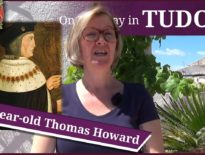On this day in Tudor history, 22nd May 1541, following their elections on St George’s Day, 23rd April 1541, Edward Seymour, Earl of Hertford; Henry Howard, Earl of Surrey; Sir John Gage, and Sir Anthony Wingfield were all installed as Knights of the Garter.
Who were these men and what was the Order of the Garter?
I introduce these Garter Knights and explain the origins of the Order of the Garter, England's oldest order of chivalry, in this video:
Also on this day in Tudor history, 22nd May 1538, Franciscan friar John Forest met his end at Smithfield in London for his allegiance to the Church of Rome. His death, along with the burning of a religious statue from Wales, was said to be the fulfilment of a prophecy made about the statue. Find out more in last year’s video:
Also on this day in history:
- 1490 – Death of Edmund Grey, 1st Earl of Kent.
- 1537 – Edward Seymour, brother of Jane Seymour, was sworn in as a Privy Councillor.
- 1539 – Probable birthdate of Edward Seymour, 1st Earl of Hertford and son of Edward Seymour, Duke of Somerset (the Edward mentioned above). Hertford was also the husband of Katherine Grey, sister of Lady Jane Grey.
- 1570 – Death of John Best, Bishop of Carlisle. He was buried in Carlisle Cathedral.
Transcript:
22 May
On this day in Tudor history, 22nd May 1541, following their elections on St George’s Day, 23rd April 1541, Edward Seymour, Earl of Hertford; Henry Howard, Earl of Surrey; Sir John Gage, and Sir Anthony Wingfield were all installed as Knights of the Garter.
Hertford replaced Sir William Kingston, former Constable of the Tower of London, who had died in 1540, Surrey replaced Thomas Cromwell, who had been beheaded in July 1540, Gage replaced George Talbot, Earl of Shrewsbury, who’d died in 1538, and Wingfield replaced William, Lord Sandys, who had died in 1540.
Let me give you a few facts about these men, who were all in favour in 1540, and also some facts about the Order of the Garter…
• Edward Seymour, Earl of Hertford, was, of course, the brother of the late Queen Jane Seymour and uncle of the future King Edward VI, for whom he’d act as Lord Protector. His sister’s marriage to the king had definitely helped his court career and he’d also become more influential following the fall of Cromwell.
• Henry Howard, Earl of Surrey, was the son of Thomas Howard, 3rd Duke of Norfolk, and the cousin of the present queen, Catherine Howard. His father was the premier duke in the land and the Earl Marshal of England.
• Sir John Gage had started his career under Henry VII and had served Henry VIII loyally for many years in a number of offices. In 1540, he was made comptroller of the royal household, Constable of the Tower of London, and was also appointed to the privy council.
• Sir Anthony Wingfield was a soldier and administrator who’d started serving King Henry VIII right at the start of his reign as an esquire of the body. He helped the Duke of Suffolk put down the Lincolnshire revolt in 1536 and had been appointed to the privy council in 1539. As captain of the guard, he’d arrested Thomas Cromwell in June 1540. He was also vice-chamberlain of the king’s household.
• The Most Noble Order of the Garter was founded in 1348 by King Edward III, who was inspired by the legendary King Arthur and his Knights of the Round Table. It is the oldest order of chivalry in England.
• When Edward III founded it, it consisted of him, his son, Edward, the Black Prince, and twenty four other knights. Traditionally, the order consists of the monarch, the Prince of Wales and no more than 24 knights.
• Historically, if a member died or was degraded for some reason, elections would be held to fill their place, but the monarch had the final say.
• The patron saint of the order is St George and it is on his feast day, 23rd April, that appointments to the order are announced.
• The motto of the order is Honi soit qui mal y pense (Shame on him who thinks this evil)
• The home of the Order is St George’s Chapel, Windsor, and still today, every June there is Garter Day, when the queen invests new members in the Throne Room of Windsor Castle before a special lunch. The queen and all the knights in their garter robes then process with a marching band to St George’s Chapel for a special service where the new members are installed.
• Each Garter Knight displays their banner of arms, helmet, crest and sword in their own stall in St George’s Chapel as well as having a special stall plate there. When a member dies, their banner is taken down, but their stall plate remains.
• The ceremonial costume consisted of a velvet mantle, which is now a dark blue, with the garter badge depicting the heraldic shield of St George’s Cross surrounded by the garter, a black velvet bonnet with feathers, a collar of gold heraldic knots, and the garter, which is worn around the left calf.
• During Henry VIII’s reign, fifty-three men were appointed to the Order of the Garter. These included Thomas Howard, 2nd Duke of Norfolk; Charles Brandon, Duke of Suffolk; Thomas Boleyn, Earl of Wiltshire; Henry Fitzroy, Duke of Richmond and Somerset, and the king’s illegitimate son; King Francis I of France; King James V of Scotland; Thomas Cromwell; and John Dudley, later Duke of Northumberland.
• St George’s Chapel is a wonderful place to visit. I was so happy to see Thomas Boleyn’s stall plate when I visited.



Leave a Reply